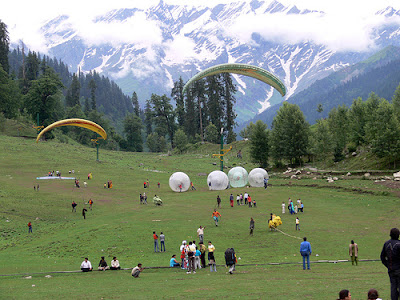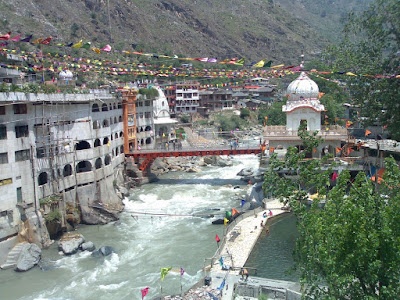Manali is a beautiful hill station in the Beas River valley in the mountains of Himachal Pradesh, India, near the northern end of the Kullu Valley. It is located about 250 kilometres (155 mi) north of state capital, Shimla. Manali is famous for its scenic natural beauty, hot water spring, Rohtang pass and Manikaran. It is also famous for travellers going to Leh by road via Manali.
How to Reach: By Road/ By Rail/ By Air
By Air: The nearest airport is at Bhuntar, which is about 50 km (31 mi) from Manali.
By Rail: Manali is not easily approachable by rail. The nearest broad gauge railheads are at Chandigarh (315 km (196 mi)), Pathankot (325 km (202 mi)) and Kalka (310 km (190 mi)). The nearest narrow gauge railhead is at Joginder Nagar (135 kilometres (84 mi)).
By Road: Manali is well connected by Road from Delhi/Chandigarh. There are many Government and Private bus service available to go to Manali from Delhi, Chandigarh and Dharamshala. Going by bus from Delhi/Chandigarh is recommended. On the way from Mandi to Manali river Beas will be at your right side up to Manali. All the scenic places will start from here.
Some people take Delhi – PathanKot - Joginder Nagar -Manali route to reach Manali and return via Manali-Chandigarh-Delhi route.
One can also check the “Access to Himachal Pradesh” on himachal Pradesh tourism development site http://hptdc.nic.in/access1.htm and for trains one can access the Indiain Railway website.
Following are the various distance to Manali:
Delhi to Manali (via Chandigarh) is around 521 km
Chandigarh to Manali (Kullu) is 325km.
Chandigarh to Shimla is around 117km.
Shimla to Manali is around 270km.
Pathankot to Manali (Kullu) is around 325km.
Climate: The climate of Manali remains pleasant mostly through the year. In winters (December to February) the temperature can dip as low as -7°C. Temperature ranges from 10°C to 25°C and the climate remains pleasant during the day and cold during the night. Monsoons last from July to September and is best avoided due to landslides. Rohtang Pass is open only from end of May to September. In winter when the temperature goes below the freezing then heavy woollen cloths are required. In summer light woollen cloths are required.
Best time to visit Manali: March - June. Best time to enjoy paragliding, rafting, zorbing and mountain sports. Whereas winters are the best time for winter sports (skiing etc.).
Places to visit in Manali:
Hadimba Temple (1 km): Built in 1553 with a superbly crafted four tiered pagoda roof, it is famous for its exquisitely carved doorway. It is dedicated to Hidimbi Devi, sister of Hidimba, who was a character in the Indian epic, Mahabharata.
Vashist Hot Water Springs: Vashist, a small village located at a distance of around 6km from Manali town, on the left bank of river Beas towards Rohtang pass is worth a visit. It is renowned for its hot springs and temples. Nearby is the pyramidal stone temple dedicated to Vashist Muni. There is another Temple of Lord Ram here. Natural hot sulphur springs with two separate bathing tanks for gents and ladies are always full of tourists. Turkish style showers fitted baths have also been built nearby. Hot water from the nearby spring is provided for bathing.
Solang Valley: Solang valley is a nice place that offers a panoramic view of mountains and valleys. It is located about 15 km. from Manali and is situated between Beas Kund and Solang village. The valley is an ideal place for adventure sports like parasailing, paragliding and other adventurous activities. It also includes several adventure school camps with hotels and guest houses. If vacationers really wish to make their trip memorable, then they must visit Solang Valley.
Manikaran: About 45 Km from Kullu in the Parvati Valley is Manikaran. It is around 80 Kms from Manali via Kullu town. By turning Kullu - Manali road at Bhunter and crossing a bridge over river Parvati, move towards Manikaran. One can reach Bhuntar in Kullu, from where a vehicle will pick you up and drop you to Manikaran. On the way to Manikaran, River Parvati is always on the left side. It is a famous pilgrimage destination for Hindu and Sikh community, in the state of Himachal Pradesh. The region is also mythologically important to the Hindus who believe that the consort of Lord Shiva, Goddess Parvati, lost her earrings in this region which resulted in the eruption of the hot springs on the banks of the River Parvati that runs down the region. Afterwards, the Sikh preacher Guru Nanak discovered the place newly and since then a Gurudwara was constructed by the side of the hot water spring and river Parvati. There is a hot spring that is located in the Gurudwara complex and the place also provides the devotees with free food. Manikaran is known for its hot springs. The water of spring is so hot that even one can cook food in that water. The water of these hot springs is famous for healing or remedy of diseases. One can enjoy a dip in the hot waters from the springs. There are altogether three baths, one is located under the Gurudwara itself and the other two are privately owned and located in guesthouses.
Rohtang Pass: Rohtang Pass is about 51 km. from Manali. Situated at an altitude of 13,050 feet above sea level, its chilly in summer too. Near by is a small lake, Dassaur Lake which is the main source of river Beas.
Rohtang Pass: Rohtang Pass is about 51 km. from Manali. Situated at an altitude of 13,050 feet above sea level, its chilly in summer too. Near by is a small lake, Dassaur Lake which is the main source of river Beas.
The pass is open from May to November. The weather of Rohtang pass is quite unpredictable. It has a well-deserved reputation for being dangerous because of unpredictable snowstorms and blizzards. The road through the Kullu Valley, past Manali and over the Rohtang Pass to Keylong, and Lahul and on to Ladakh, becomes very busy during the summer months as an alternate military route, following the Kargil Conflict in 1999 and in addition to tensions in Kashmir. Traffic jams are common as military vehicles, trucks, and goods carriers try to navigate the tight roads and rough terrain, compounded by snow and ice at certain points and the large number of tourists vehicles. Partially due to the military significance of the pass, the Indian government began building the $320 million Rohtang Tunnel project in 2010 which promises to create a year-around link which is much safer and faster.
On the southern side of this pass, the Beas River emerges from underground and flows southward and on its northern side, the Chandra River, a source stream of the river Chenab, flows westward.
If you want to visit Rohtang pass during your visit, you are advised to start around 5am from Manali, so that you can go up to the top of Rogtang pass. During the day time in peak season the Rohtang pass is blocked due to lot of tourist vehicles and you will not be able to visit the top of Rohtang pass.
Also visit travelogue for Assam - Arunachal Pradesh , Leh – Ladakh and Andaman and nicobar islands. For any queries/suggestions write in the comment block below.






Mornings, everywhere in the world, take their own peculiar rhythms; carefully etched compromises between the body's perpetual reluctance and civilization's unflagging persistence. My experience in Kathmandu was no exception.
ReplyDeleteFlights to Lusaka | Cheap Flights to Lusaka | Cheap Air Tickets to Lusaka